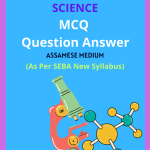Class 7 Science MCQ Chapter 1 Nutrition in Plants Solutions in English Medium, Class 7 Science Multiple Choice Question Answer in English to each chapter is provided in the list so that you can easily browse throughout different chapters Class 7 Science MCQ Chapter 1 Nutrition in Plants Notes and select need one.
Class 7 Science MCQ Chapter 1 Nutrition in Plants
Also, you can read the SCERT book online in these sections Class 7 Science Objective Type Solutions by Expert Teachers as per SCERT (CBSE) Book guidelines. These solutions are part of SCERT All Subject Solutions. Here we have given Assam Class 7 Science MCQs Solutions in English for All Subject, You can practice these here.
Nutrition in Plants
Chapter – 1
| MCQ |
1. Why are manure and fertilisers added to the soil?
(a) To increase soil pH.
(b) To replenish plant nutrients.
(c) To decrease soil moisture.
(d) To remove harmful bacteria.
Ans: (b) To replenish plant nutrients.
2. Which nutrient is particularly needed by crops to make proteins?
(a) Phosphorous.
(b) Potassium.
(c) Nitrogen.
(d) Calcium.
Ans: (c) Nitrogen.
3. What role does the bacterium Rhizobium play in nutrient replenishment?
(a) It converts nitrogen into a soluble form.
(b) It increases soil acidity.
(c) It provides phosphorus to plants.
(d) It decomposes organic matter.
Ans: (a) It converts nitrogen into a soluble form.
4. Where does Rhizobium live to provide nitrogen to plants?
(a) In the soil.
(b) In the leaves of plants.
(c) In the roots of leguminous plants.
(d) In the stems of non-leguminous plants.
Ans: (c) In the roots of leguminous plants.
5. What is the relationship between Rhizobium bacteria and leguminous plants?
(a) Competitive.
(b) Parasitic.
(c) Symbiotic.
(d) Predatory.
Ans: (c) Symbiotic.
6. What do green plants use to synthesise their food?
(a) Carbohydrates and oxygen.
(b) Carbon dioxide, water, and minerals.
(c) Oxygen and nitrogen.
(d) Glucose and sunlight.
Ans: (b) Carbon dioxide, water, and minerals.
7. What is the process called by which green plants synthesise their food?
(a) Respiration.
(b) Digestion.
(c) Photosynthesis.
(d) Fermentation.
Ans: (c) Photosynthesis.
8. Which of the following is NOT essential for photosynthesis?
(a) Chlorophyll.
(b) Water.
(c) Oxygen.
(d) Sunlight.
Ans: (c) Oxygen.
9. What are the products of photosynthesis?
(a) Carbohydrates and oxygen.
(b) Nitrogen and water.
(c) Glucose and carbon dioxide.
(d) Proteins and carbon dioxide.
Ans: (a) Carbohydrates and oxygen.
10. What role does chlorophyll play in photosynthesis?
(a) It stores energy in the form of food.
(b) It absorbs sunlight.
(c) It produces oxygen.
(d) It converts food into energy.
Ans: (b) It absorbs sunlight.
11. How is solar energy stored in plants?
(a) In the form of carbohydrates.
(b) In the form of oxygen.
(c) In the form of proteins.
(d) In the form of water.
Ans: (a) In the form of carbohydrates.
12. Which type of organisms are saprotrophs?
(a) Green plants.
(b) Animals.
(c) Fungi.
(d) Cuscuta plants.
Ans: (c) Fungi.
13. What is the term for plants like Cuscuta that take food from a host plant?
(a) Autotrophs.
(b) Heterotrophs.
(c) Saprotrophs.
(d) Parasites.
Ans: (d) Parasites.
14. Which of the following are heterotrophs?
(a) Green plants.
(b) Fungi.
(c) Bacteria.
(d) A few plants and all animals.
Ans: (d) A few plants and all animals.
15. Why is oxygen released during photosynthesis important?
(a) It is used by plants for growth.
(b) It is utilised by living organisms for their survival.
(c) It is stored as food in the leaves.
(d) It helps plants absorb sunlight.
Ans: (b) It is utilised by living organisms for their survival.

Hi! my Name is Parimal Roy. I have completed my Bachelor’s degree in Philosophy (B.A.) from Silapathar General College. Currently, I am working as an HR Manager at Dev Library. It is a website that provides study materials for students from Class 3 to 12, including SCERT and NCERT notes. It also offers resources for BA, B.Com, B.Sc, and Computer Science, along with postgraduate notes. Besides study materials, the website has novels, eBooks, health and finance articles, biographies, quotes, and more.



